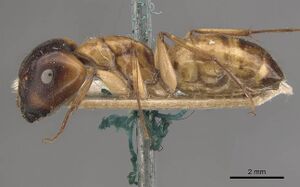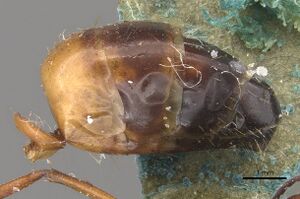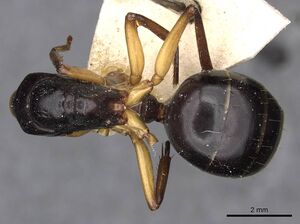Camponotus claripes
| Camponotus claripes | |
|---|---|

| |
| Scientific classification | |
| Kingdom: | Animalia |
| Phylum: | Arthropoda |
| Class: | Insecta |
| Order: | Hymenoptera |
| Family: | Formicidae |
| Subfamily: | Formicinae |
| Tribe: | Camponotini |
| Genus: | Camponotus |
| Species: | C. claripes |
| Binomial name | |
| Camponotus claripes Mayr, 1876 | |
| Subspecies | |
| |
| Synonyms | |
| |
If disturbed, minor workers have the interesting defence mechanism of drawing their limbs close to their bodies and feigning death (thanatosis). This ruse is particularly effective if they are on tree-trunks, when they will free-fall to the ground if touched. Lying immobile among vegetation, twigs and leaf litter, these small medium ants are then almost impossible to find. (Heterick 2009)
Identification
This species is not uncommon in some Perth coastal parklands where native vegetation persists, and has also been collected as far east as Coolgardie, and as far north as Shark Bay (Heterick 2009).
Identification
Heterick (2009) - Described from a major worker from East Wallabi Island in the Abrolhos, and the colour is given as ‘brownishblack’ (Forel 1893). Specimens from NSW believed to be C. walkeri are held in SAMA, and these have lighter brown bodies. All specimens I have seen from WA, however, are black with light yellow legs.
Keys including this Species
- Key to Australian Camponotus species
- Key to Australian Camponotus majors of the southwestern Botanical Province
- Key to Australian Camponotus minors of the southwestern Botanical Province
Distribution
Latitudinal Distribution Pattern
Latitudinal Range: -16.73333333° to -37.75°.
| North Temperate |
North Subtropical |
Tropical | South Subtropical |
South Temperate |
- Source: AntMaps
Distribution based on Regional Taxon Lists
Australasian Region: Australia (type locality).
Distribution based on AntMaps
Distribution based on AntWeb specimens
Check data from AntWeb
Countries Occupied
| Number of countries occupied by this species based on AntWiki Regional Taxon Lists. In general, fewer countries occupied indicates a narrower range, while more countries indicates a more widespread species. |

|
Estimated Abundance
| Relative abundance based on number of AntMaps records per species (this species within the purple bar). Fewer records (to the left) indicates a less abundant/encountered species while more records (to the right) indicates more abundant/encountered species. |

|
Biology
Association with Other Organisms
 Explore: Show all Associate data or Search these data. See also a list of all data tables or learn how data is managed.
Explore: Show all Associate data or Search these data. See also a list of all data tables or learn how data is managed.
Nematode
- This species is a host for the nematode Mermithidae (unspecified "Mermix") (a parasite) in Australia (NSW) (Wheeler, 1933; Laciny, 2021).
Castes
Worker
Images from AntWeb
   
| |
| Worker. Specimen code casent0906933. Photographer Michele Esposito, uploaded by California Academy of Sciences. | Owned by NHMUK, London, UK. |
   
| |
| Syntype of Camponotus claripes inverallensis. Worker (major/soldier). Specimen code casent0910368. Photographer Will Ericson, uploaded by California Academy of Sciences. | Owned by MHNG, Geneva, Switzerland. |
   
| |
| Syntype of Camponotus claripes inverallensis. Worker. Specimen code casent0910369. Photographer Will Ericson, uploaded by California Academy of Sciences. | Owned by MHNG, Geneva, Switzerland. |
    
| |
| Syntype of Camponotus claripes nudimalis. Worker (major/soldier). Specimen code casent0910370. Photographer Will Ericson, uploaded by California Academy of Sciences. | Owned by MHNG, Geneva, Switzerland. |
  
| |
| Specimen code casent0910405. . | |
  
| |
| Specimen code casent0910406. . | |
Nomenclature
The following information is derived from Barry Bolton's Online Catalogue of the Ants of the World.
- claripes. Camponotus claripes Mayr, 1876: 64 (s.w.) AUSTRALIA (Queensland).
- Type-material: syntype major and minor workers (numbers not stated).
- [Note: McArthur, 2009: 274, cites 2w major, 2w minor syntypes NHMW.]
- Type-localities: Australia: Queensland, Peak Downs (no collector’s name), Queensland, Gayndah (no collector’s name).
- Type-depository: NHMW.
- Forel, 1902h: 496 (q.).
- Combination in C. (Myrmophyma): Forel, 1914a: 269;
- combination in C. (Thlipsepinotus): Santschi, 1928e: 483.
- Status as species: Dalla Torre, 1893: 225; Emery, 1896d: 374 (in list); Forel, 1902h: 496; Forel, 1907a: 34; Forel, 1907h: 300; Forel, 1913g: 191; Emery, 1925b: 110; Clark, 1928c: 44; Wheeler, W.M. 1933b: 26; Taylor & Brown, 1985: 111; Taylor, 1987a: 11; Bolton, 1995b: 92; McArthur, 2007a: 342; McArthur, 2009: 274 (redescription); Heterick, 2009: 67; McArthur, 2010: 76; McArthur, 2014: 52.
- Senior synonym of piperatus: McArthur, 2009: 274.
- Senior synonym of walkeri: Heterick, 2021: 6.
- Distribution: Australia.
- Current subspecies: nominal plus nudimalis, orbiculatopunctatus.
- piperatus. Camponotus (Myrmophyma) claripes subsp. piperatus Wheeler, W.M. 1933b: 26, fig. 2 (s.w.q.) AUSTRALIA (South Australia, Victoria, New South Wales).
- Type-material: syntype major and minor workers (numbers not stated), 1 syntype queen .
- Type-locality: Australia: South Australia, Mt Lofty, 3.viii.1931 (W.M. Wheeler).
- Type-depository: MCZC.
- Subspecies of claripes: Taylor & Brown, 1985: 112; Taylor, 1987a: 11; Bolton, 1995b: 117.
- Junior synonym of claripes: McArthur, 2009: 274.
- walkeri. Camponotus walkeri Forel, 1893d: 454 (s.) AUSTRALIA (Western Australia).
- Type-material: holotype (?) major worker.
- [Note: no indication of number of specimens is given.]
- Type-locality: Australia: Western Australia, Baudin I. (J.J. Walker).
- Type-depository: MHNG.
- Forel, 1910b: 72 (w.).
- Combination in C. (Myrmophyma): Forel, 1914a: 269.
- Status as species: Emery, 1896d: 374 (in list); Forel, 1902h: 495; Forel, 1907h: 300; Forel, 1910b: 72; Forel, 1915b: 100; Emery, 1925b: 112; Wheeler, W.M. 1934d: 160; Taylor & Brown, 1985: 121; Taylor, 1987a: 15; Bolton, 1995b: 129; McArthur, 2007a: 337; Heterick, 2009: 70; McArthur, 2014: 138.
- Junior synonym of claripes: Heterick, 2021: 6.
Type Material
- Camponotus claripes: Syntype, workers, Peak Downs and Gayndah, Queensland, Australia.
- Camponotus (Myrmophyma) claripes piperatus: Syntype, 12 workers, 8 queens, Mt. Lofty, South Australia, Australia, Museum of Comparative Zoology.
- Camponotus walkeri: Syntype, worker(s), Baudin Island, Western Australia, Australia, Musee d'Histoire Naturelle Genève.
Unless otherwise noted the text for the remainder of this section is reported from the publication that includes the original description.
Description
Worker: Length 6-10 mm. Black or brown black, most frequently all the legs including the coxa and femur either yellow or reddish yellow, in these (especially in the minor worker) with a brownish-black ring before the apex, with tibia and tarsus either yellow or chestnut colored, in the minor worker the body is sometimes yellow with the posterior half of the head and the gaster dull black and the dorsum of the thorax more or less dusky; scattered pilosity and very dispersed adpressed pubescence, antennae and legs without erect hair,shining, weak mandibles with dispersed punctation (very finely coriaceous) the anterior half of the head densely punctated and sub opaque with large scattered punctures; clypeus is not strongly carinate, the anterior margin in the major worker has 2 obtuse teeth, in the minor worker it is bow shaped; the thorax is convex above the propodeum angle, in the major worker there is a distinct short transverse scutellum and next is a little transverse depression; the scale of the petiole is ovate.
Camponotus (Myrmophyma) claripes piperatus
Worker maxima. Length 8-10 mm.
Head shaped as in the typical claripes, but with slightly more convex sides; thorax shorter and higher, especially at the epinotum, which has a much steeper concave declivity, distinctly longer than the convex base. Punctures on the subopaque clypeus and cheeks smaller, more superficial and not elongated. Pilosity as in the type, but somewhat less abundant on the cheeks. Color brownish ivory yellow, legs paler; tip of gaster, a band across each of its more anterior segments, apex of the petiolar node, epinotum, sides of the mesonotum and more or less of the dorsal surface of the head brown or dark brown, the pronotum and paler portions of the gaster spotted with brown; tip of mandibles, antennal funiculi, tarsi, knees and tips of tibiae, clypeus, gula, corners of the head, and a broad transverse band on each cheek yellowish or brownish red.
Worker minima. Length 4-6 mm.
Smaller than the minima of the typical claripes, with distinctly broader head and shorter and more convex thorax, the base of the epinotum more rounded and less distinctly marked off from the declivity. Ivory yellow, legs somewhat paler and more whitish; mandibles, funiculi, tarsi, knees and tips of tibiae reddish; posterior third or fourth of the head, dorsal border of petiole and two last segments of the gaster dark brown; each of the gastric segments with a narrow posterior brown fascia, the remainder of its dorsal surface and that of the thorax spotted with brown.
Female. Length 11-12 mm.
Closely resembling the female claripes in form, but the sculpture of the clypeus and cheeks as in the maxima. Head similarly colored, but the thorax dark brown, except the pronotum and mesosterna, which are dull ivory yellow, spotted with brown; gaster dark brown with only the anterior and posterior borders of the segments and the anterior surface of the first segment ivory yellow, the latter with brown spots. Wings long (12 mm), distinctly infuscated, and as in the typical claripes, with resin-brown veins and pterostigma.
South Australia: Mt. Lofty, type locality (Wheeler) worker Female; Adelaide (F.R. Zietz, A.M. Lea) worker Female; Belair (J.W. Haacke) Female. Victoria: Sea Lake and Ultima (J.C. Goudie) worker. New South Wales: The Creel, Mt. Kosciusko, 3000 ft. (Wheeler) worker Female; Jenolan Caves (J.C. Wiburd) worker; Katoomba (Wheeler) worker. Some of these series show departures in coloration, but they are not sufficiently constant to justify distinct varietal names. Thus the maximae from the two localities in Victoria have the gaster almost entirely dark brown, and those from Katoomba not only show considerable variation in the amount of dark brown in the gaster but often have the entire head reddish yellow, with the exception of a median spot on the vertex. The single mermithergate of C. piperatus was taken December 14, 1931, from a small colony at the Creel on Mt. Kosciusko on the same hillside as the eight consobrinus mermithergates described above. It measures 10.3 mm. and is therefore somewhat longer than the normal maxima. The head measures 1.6 mm., the gaster, containing a well developed Mermis, 5.3 mm. The general aspect of the specimen is that of a huge minima, but the head is distinctly broader in proportion to its length and the thorax and petiole are those of a maxima. The thorax has a distinct metathoracic sclerite and the epinotum is high, with a perceptible angle between the base and declivity. The petiolar node is robust, with a feebly notched superior border. The anterior portion of the head approaches that of the maxima in having a more uneven and more coarsely punctate surface than the minima. The color, too, is like that of the maxima, since the mesonotum and posterior portion of the epinotum are dark brown. The gaster is very pale even at the tip; the brown spots are pronounced on the pronotum, but pale and scattered on the gaster. Except for the smaller and narrower head, the specimen might be said to resemble a media, but this subcaste, as previously stated, does not seem to exist in claripes.
References
- Bolton, B. 1995b. A new general catalogue of the ants of the world. Cambridge, Mass.: Harvard University Press, 504 pp. (page 92, catalogue)
- Forel, A. 1902j. Fourmis nouvelles d'Australie. Rev. Suisse Zool. 10: 405-548 (page 496, queen described)
- Forel, A. 1914a. Le genre Camponotus Mayr et les genres voisins. Rev. Suisse Zool. 22: 257-276 (page 269, combination in C. (Myrmophyma))
- Heterick, B. E. 2009a. A guide to the ants of South-western Australia. Records of the Western Australian Museum, Supplement 76: 1-206. Part 1.
- Heterick, B.E. 2021. A guide to the ants of Western Australia. Part I: Systematics. Records of the Western Australian Museum, Supplement 86, 1-245 (doi:10.18195/issn.0313-122x.86.2021.001-245).
- Heterick, B.E. 2022. A guide to the ants of Western Australia. Part II: Distribution and biology. Records of the Western Australian Museum, supplement 86: 247-510 (doi:10.18195/issn.0313-122x.86.2022.247-510).
- Mayr, G. 1876. Die australischen Formiciden. J. Mus. Godeffroy 12: 56-115 (page 64, soldier, worker described)
- Santschi, F. 1928e. Nouvelles fourmis d'Australie. Bull. Soc. Vaudoise Sci. Nat. 56: 465-483 (page 483, combination in C. (Thlipsepinotus))
- Wheeler, W.M. 1933. Mermis parasitism in some Australian and Mexican ants. Psyche 40: 20-31.
References based on Global Ant Biodiversity Informatics
- Forel A. 1910. Formicides australiens reçus de MM. Froggatt et Rowland Turner. Rev. Suisse Zool. 18: 1-94
- Heterick B. E. 2009. A guide to the ants of south-western Australia. Records of the Western Australian Museum Supplement 76: 1-206.
- Heterick B. E., B. Durrant, and N. R. Gunawardene. 2010. The ant fauna of the Pilbara Bioregion, Western Australia. Records of the Western Australian Museum, Supplement 78: 157-167.
- McArthur A. J. 2009. New species, new status and new synonymy for Camponotus from Australia (Hymenoptera: Formicidae). Myrmecological News 12: 273-286.
- Miller L. J., and T. R. New. 1997. Mount Piper grasslands: pitfall trapping of ants and interpretation of habitat variability. Memoirs of the Museum of Victoria 56(2): 377-381.
- Taylor R. W. 1987. A checklist of the ants of Australia, New Caledonia and New Zealand (Hymenoptera: Formicidae). CSIRO (Commonwealth Scientific and Industrial Research Organization) Division of Entomology Report 41: 1-92.
- Wheeler W. M. 1933. Mermis parasitism in some Australian and Mexican ants. Psyche (Cambridge) 40: 20-31.

